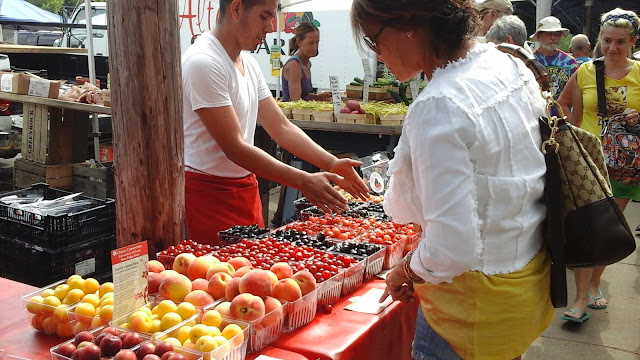We just returned from a wonderful vacation in Michigan. I grew up there, attended Michigan State University, where I met my future husband. After Dave graduated from law school, we got married and moved to New England shortly thereafter. Since we hadn't been back in eight years, we did our best to cover as much of the state as possible, visiting friends and relatives along the way. We traveled from Detroit north to Traverse City, south to Saugatuck and east to Chelsea.
After picking up our rental car in Detroit we headed northwest to our first stop - Parshallville, in Livingston County. Parshallville is a picturesque village where my parents retired. In a few weeks, the Parshallville Cider Mill will be a bustling place, but today, we had the village to ourselves.
Our stop was brief. We strolled around the grist mill and walked by the home where my parents had moved after I left for college. The house is close to two-hundred years old and has gone through several renovations. Although it looked very different from when my parents lived there over three decades ago, I was happy to see that the house is being well cared for and enjoyed. Back on the highway, we continued driving north on U.S. 23 before bearing east toward Traverse City. We arrived just in time to enjoy the beautiful colors of the sunset (below).

Traverse City's tourism has grown significantly in the last decade with the region consistently ranking high in national ratings as a not to be missed destination. In 2012 Traverse City was listed as one of “America’s 10 Hottest Cold Cities” at Livability.Com; as a Best Summer Trip in National Geographic; and a "Top Seven Beer Destinations in North America" by the Travel Channel. During the summer, hotel rooms are at a premium and need to be reserved well in advance. After unsuccessfully searching for traditional lodging, I decided to try Airbnb for the first time. Not knowing what to expect, we were very pleased with our choice. We shared a two bedroom condo with the owner, just outside of town. Over the three days we were there, our paths never crossed, so we basically had the entire unit to ourselves at a cost a fraction of the price of a regular hotel.
In the morning the next day we browsed the shops of downtown.Like the Northeast Kingdom of Vermont, Traverse City sits within the 45th degree parallel.
Approximately Seventy-Five percent of the cherries produced in the United States come from Michigan and Traverse City has become known the "Cherry Capital" if the world. Thankfully, we missed the Cherry Festival which coincided with the Fourth of July weekend. I wouldn't want to deal with the crowds. But it was still cherry harvesting season, so fresh cherries were plentiful at the Saturday morning farmers market.
Once cherry season is over, one can visit Cherry Republic and buy pretty much anything cherry flavored, including their own cherry-based wines. Free samples and tastings are available throughout the store.
Down by the water are bike rentals which can be used on the miles of surrounding bike paths, or if you want to cool off on the water, there are paddle board and kayak rentals. We chose the later.
On Friday evening, our friends Tom and Kathryn took us out on their boat into Grand Traverse Bay. It was perfect weather and a great way to relax after a very busy day.
 |
| Leaving the Harbor |
Saturday ignored the forecast of rain and turned out gorgeous. We took a drive up to Suttons Bay, then over to Leeland. Leland is an active commercial fishing village, with the docks and shanties of "Fishtown" listed on the National Register of Historic Places.
 |
| Waterfall view from the deck of The Cove restaurant |
|
|
|
 |
| and their famous Chubby Mary drink |
|
I was glad that we got the opportunity to do a little hiking. First to the top of Rattlesnake Hill (below)
And then up the Sleeping Bear Dunes, which was voted as the "Most Beautiful Place in America" by Good Morning America viewers in 2011. Hiking the dunes takes some endurance, but it's great exercise and provides a lot of cushion on the knees going down!

I have decided to break our vacation up into several blog posts, since after I started writing I realized that we saw too much to cover in one post. I took lots of pictures and made mental notes, so stay tuned for further coverage.






































